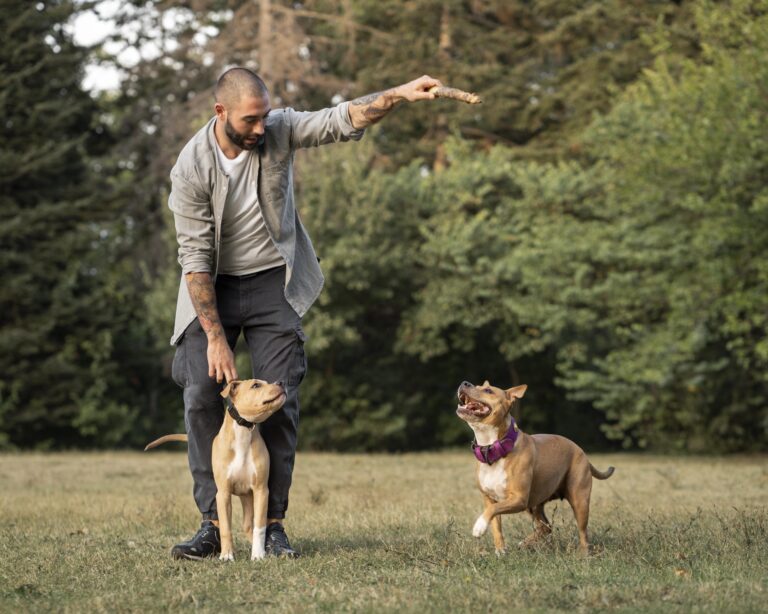Decoding Dog Behavior: Understanding Your Canine Companions Body Language
Understanding Your Dogs Body Language and Behavior: Learn how to interpret your dogs body language cues, recognize signs of anxiety and stress, and enhance communication through training and socialization. Explore Off Leash K9 Trainings website for effective training solutions.
Introduction: Understanding the Importance of Dog Body Language
Dogs communicate primarily through body language cues, which serve as a key indicator of their emotional state and intentions. Interpreting your dog’s body language is essential for effective communication, building a strong bond, and ensuring their well-being. Recognizing signs of anxiety, stress, and aggression in dogs can help prevent conflicts and improve the overall quality of life for your pet.
Understanding your dog’s body language is like learning a new language. For instance, when a dog has a wagging tail along with a relaxed body posture and open mouth, it typically indicates a happy and friendly demeanor. On the contrary, a dog displaying a lowered body posture, tucked tail, and avoiding eye contact may be signaling feelings of fear or discomfort. These subtle yet significant cues can provide valuable insights into your dog’s emotional state and help you respond accordingly to nurture a positive relationship with your pet.
By paying attention to your dog’s body language cues, you can deepen your connection with them and create a harmonious environment. Dogs often use their ears, eyes, mouth, and tail to express themselves, and by understanding these signals, you can better interpret their needs and emotions. This knowledge not only helps in avoiding misunderstandings but also strengthens the bond between you and your furry companion. Remember, effective communication through body language is a two-way street that fosters trust and companionship, ultimately leading to a happier and healthier relationship with your dog.
 Understanding Dog Body Language Basics
Understanding Dog Body Language Basics
Understanding your dog’s body language involves more than just observing general cues. Dogs communicate through a complex language of signals that convey their emotions and intentions. For instance, a dog’s tail wagging can signify different emotions depending on the context. A broad, high wag usually indicates happiness, while a low, slow wag might suggest uncertainty or caution. By paying attention to these subtle variations, you can better interpret your dog’s emotional state and respond accordingly.
In addition to tail movements, dogs also use their facial expressions to communicate. A relaxed mouth, bright eyes, and ears in their natural position typically indicate a happy and content dog. Conversely, a tense mouth, narrowed eyes, and flattened ears can signify discomfort or anxiety. By observing these facial cues alongside body postures, you can gain a deeper understanding of your dog’s feelings and strengthen the bond between you. Recognizing these nuances in body language can help you address your dog’s needs effectively and enhance your communication with them.
 Interpreting Canine Social Signals
Interpreting Canine Social Signals
Understanding canine social signals is crucial for dog owners to comprehend their pets’ behavior and interactions effectively. These signals play a vital role in how dogs communicate with each other and with humans, shaping their social dynamics and relationships. For instance, when two dogs meet for the first time, they often engage in a series of behaviors like sniffing, circling, and play bows to establish a rapport and determine each other’s intentions. By recognizing and interpreting these initial social cues, dog owners can better manage their pets’ interactions and prevent potential conflicts.
Moreover, canine social signals extend beyond direct interactions between dogs. Dogs also display social cues during everyday activities, such as going for walks or visiting the dog park. Observing how your dog interacts with other animals and people in these settings can provide valuable insights into their social preferences, comfort levels, and overall well-being. By paying attention to your dog’s body language and responses during social encounters, you can tailor their experiences to ensure they feel safe, happy, and engaged. This proactive approach to interpreting canine social signals fosters positive socialization experiences for your pet, contributing to their overall behavioral development and confidence in various social environments.
Recognizing Signs of Anxiety and Stress in Dogs
Recognizing signs of anxiety and stress in dogs is crucial for their well-being and your relationship with them. Beyond the commonly known signals like pacing, panting, and excessive drooling, dogs may also display subtle cues that indicate their discomfort or unease. For instance, a dog licking its lips or yawning excessively can be a sign of stress. These behaviors are their way of communicating that they are not at ease and may need your support and reassurance.
Moreover, understanding appeasement behaviors can play a vital role in diffusing tense situations among dogs. When a dog licks its lips or averts its gaze, it is attempting to communicate submissiveness and avoid conflict. By recognizing these signals, you can intervene appropriately to prevent escalations and provide a safe environment for your dog and others. Additionally, differentiating between fear-based aggression and defensive aggression is essential in addressing behavioral issues. Fear-based aggression is often a response to a perceived threat or discomfort, while defensive aggression is a protective reaction when a dog feels cornered or vulnerable. By understanding these distinctions, you can tailor your approach to help your dog feel secure and supported in various situations.
In conclusion, by being attentive to the nuanced signs of anxiety, stress, and aggression in dogs, you can proactively address their needs and strengthen your bond based on trust and understanding. Understanding these signals not only benefits your dog’s emotional well-being but also fosters a harmonious and respectful relationship between you and your furry companion.
Importance of Training and Socialization for Dogs
Proper training and socialization are essential elements in nurturing a well-rounded and behaviorally balanced dog. Training not only shapes a dog’s behavior but also enhances their responsiveness and adaptability to various environments. For instance, teaching a dog basic commands like sit, stay, and come not only fosters obedience but also establishes clear communication between the dog and the owner, strengthening their bond.
Off Leash K9 Training’s Basic Obedience program is designed to cater to dogs of all ages and breeds, focusing on instilling a solid foundation of commands and behaviors. Through structured training sessions, dogs learn to obey commands promptly, exhibit desirable behaviors, and interact positively with their surroundings. For example, a dog enrolled in the program may learn leash manners, recall commands, and how to greet people politely, enhancing their social skills and overall behavior.
Moreover, socialization is a crucial aspect of a dog’s development as it exposes them to various stimuli, environments, and interactions, promoting adaptability and confidence. By introducing dogs to different social settings, other animals, and people, socialization helps prevent behavioral issues such as fearfulness, aggression, or anxiety. Through socialization, dogs learn to navigate the world around them comfortably, leading to well-adjusted and sociable companions.
Explore Off Leash K9 Training’s website at offleashk9training.com for comprehensive training programs tailored to enhance your dog’s behavior and social skills.
Off Leash K9 Training Services for Better Understanding of Dog Behavior
Off Leash K9 Training offers a comprehensive Behavior Modification program that targets specific behavioral issues such as aggression, anxiety, and leash reactivity in dogs. For instance, if a dog displays signs of aggression towards other dogs during walks, Off Leash K9 Training’s program can help address this behavior by implementing specialized training techniques tailored to the individual dog’s needs. This focused approach ensures that pet owners receive practical solutions to manage and modify their dog’s behavior effectively, leading to a harmonious relationship between the dog and its owner.
Moreover, the training programs at Off Leash K9 Training are designed not only to address behavioral concerns but also to strengthen the communication, trust, and obedience between dogs and their owners. For example, by participating in the Basic Obedience program, dogs of all ages and breeds can learn essential commands and behaviors that promote better interaction and understanding between the pet and its owner. This foundational training sets the groundwork for a positive and cooperative relationship, establishing clear boundaries and expectations for the dog while fostering a sense of trust and respect towards the owner.
With a team of trainers globally recognized for their expertise, impeccable success rate, and commitment to providing safe and effective training solutions for dogs, Off Leash K9 Training stands out as a reputable choice for pet owners seeking professional guidance in understanding and addressing their dog’s behavior cues. By enrolling in Off Leash K9 Training’s programs, dog owners can benefit from proven training methods that not only enhance their dog’s behavior but also strengthen the bond and communication between them, ultimately leading to a happier and more fulfilling companionship.
 Tips for Reading Your Dog’s Body Language Effectively
Tips for Reading Your Dog’s Body Language Effectively
When observing your dog’s body language, it’s essential to consider various contexts and situations to gain a comprehensive understanding of their emotional state and needs. For instance, if your dog approaches you with a relaxed body posture, open mouth, and a gently wagging tail when you come home, it likely indicates happiness and excitement to see you. On the other hand, if your dog cowers with a tucked tail and avoids eye contact during a visit to the vet, they might be feeling anxious or fearful. By paying attention to these subtle variations in body language, you can tailor your responses to better support your furry companion.
Furthermore, becoming adept at recognizing nuanced cues such as ear position, tail carriage, and facial expressions can significantly enhance your ability to interpret your dog’s mood and comfort level accurately. For example, if your dog’s ears are perked up, their tail is held high, and they have a soft gaze while playing with a new toy, it typically signifies engagement and contentment. Conversely, if your dog lowers their head, averts their gaze, and tucks their tail between their legs when meeting another dog, they might be indicating submission or discomfort. By honing in on these intricate signals, you can respond appropriately to meet your dog’s needs and strengthen your bond through effective communication.
Consistent and positive reinforcement of behaviors aligned with your dog’s body language is pivotal in fostering a harmonious relationship and enhancing communication with your pet. For instance, if your dog displays relaxed body language and a wagging tail when meeting a new person, praising them and offering treats can reinforce their sociable behavior. By linking positive experiences with specific body cues, you not only encourage desirable conduct but also create a supportive environment where your dog feels understood and valued. This mutual understanding builds trust and deepens the connection between you and your canine companion.




